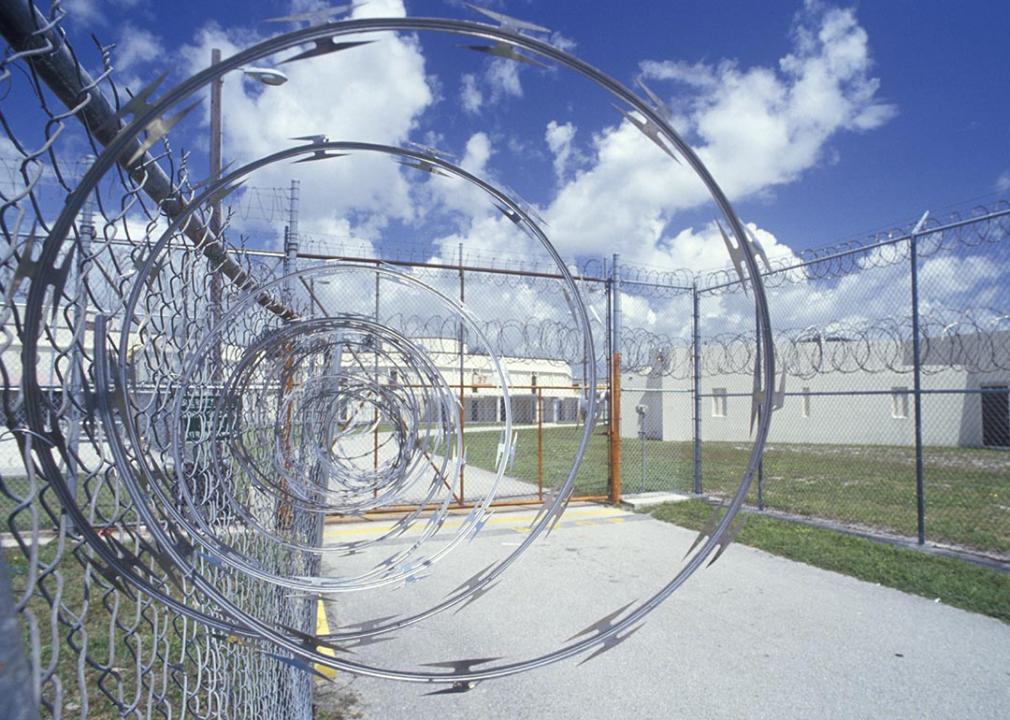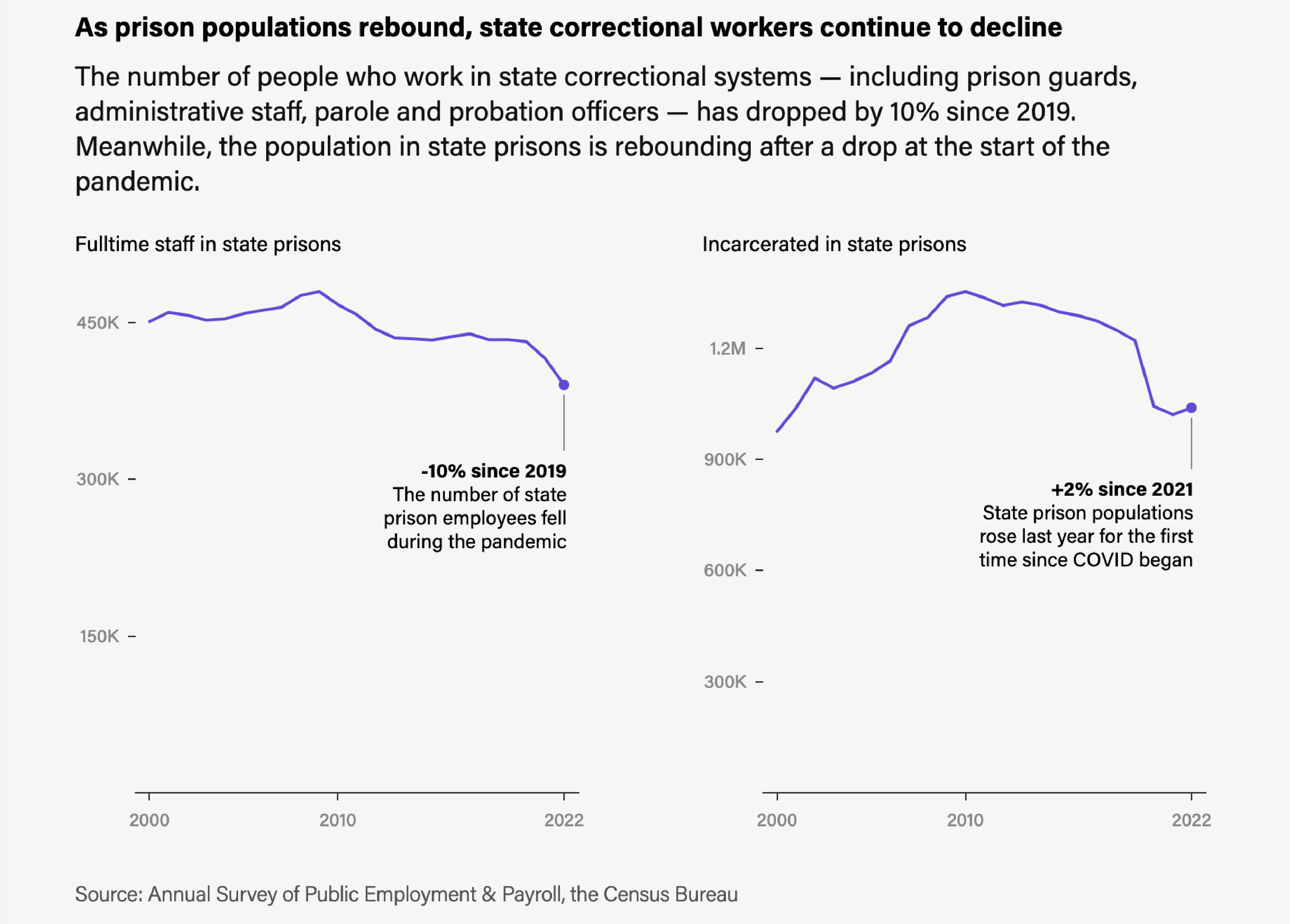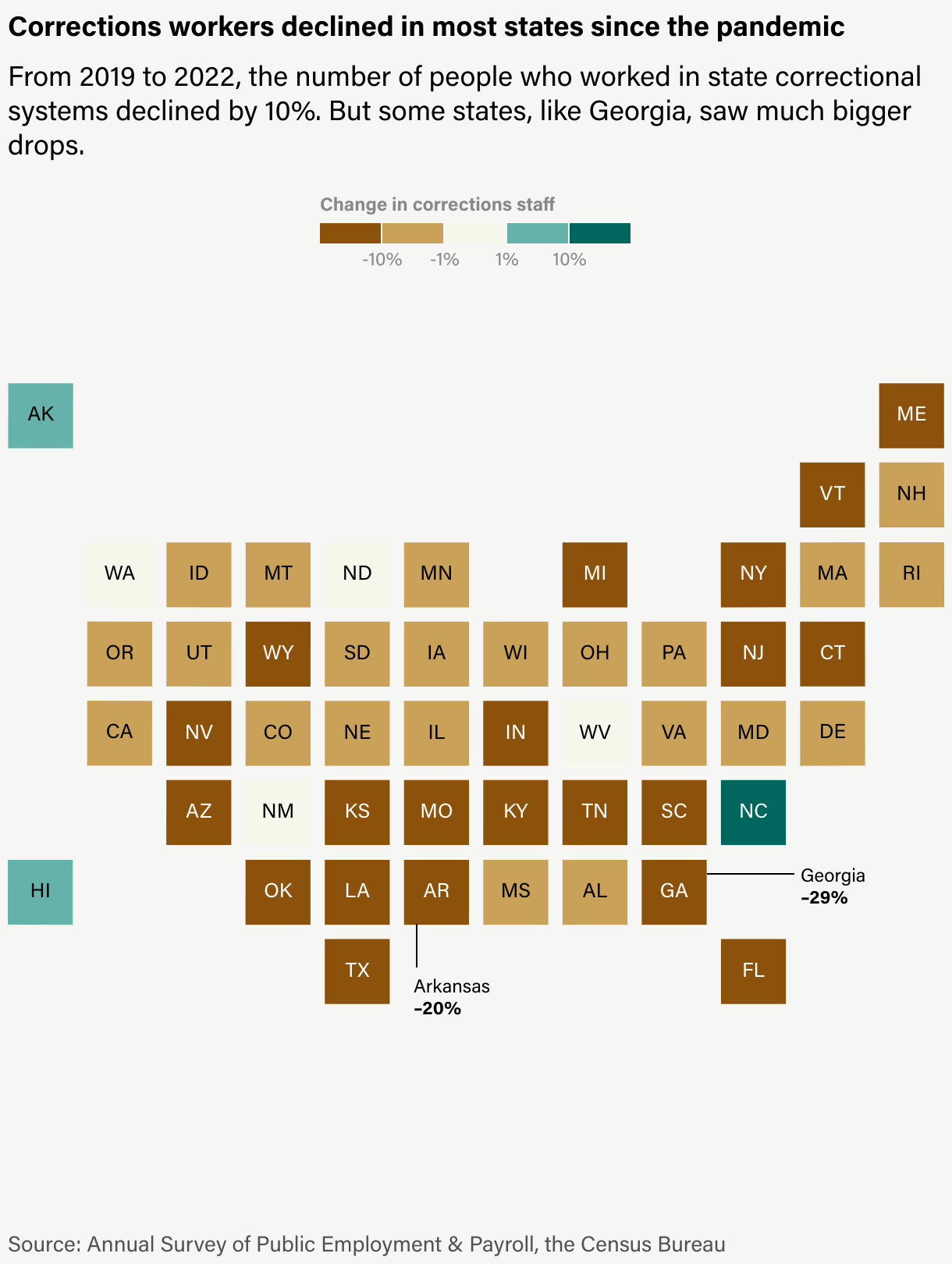Low pay, understaffed shifts, and dangerous conditions: New data shows a worsening prison staffing shortage crisis

Joseph Sohm // Shutterstock
Low pay, understaffed shifts, and dangerous conditions: New data shows a worsening prison staffing shortage crisis
close up of barbed wire fence spiral at Dade County Correctional Facility in FL
When Andrew Phillips took a job as a corrections officer at Georgia’s Smith State Prison in 2021, he was desperate for work. Shortly after he started, he noticed a problem. The prison housed about 1,500 men, and each shift was supposed to have 30 officers to guard them, but most days there were half that, according to Phillips.
He said he and his colleagues often had to work 16-hour days, five days a week. “We just had no energy, we didn’t have the ability to care,” Phillips said. The mandatory overtime, combined with constant violence against both staff and incarcerated people, led officers to quit, he said, “The place was too brutal, too disgusting.”
As prisons across the country continue to struggle with recruiting and retaining staff, The Marshall Project looks at how the most recent data from the U.S. Census Bureau shows the situation is particularly dire. In 2022, the number of people working for state prisons hit its lowest mark in over two decades.
(Pictured above: Dade County Men’s Correctional Facility, FL, an understaffed prison in Florida)
Meanwhile, state prison populations are rising. The number of people behind bars steadily declined starting in 2013 and then drastically dropped during the pandemic, when states released people to ease dangerous COVID-19 conditions, and court systems slowed. But by 2022, the number of people held in state prisons started to bounce back to over 1 million people.
Some states argue they don’t need as many workers as they did, because they closed facilities or privatized services such as health care. And not all corrections staff work inside prisons; some state corrections departments include probation and parole, juvenile facilities or jails. Still, nearly every state saw a drop in the number of people working in corrections, at a time when prison populations in many places are rebounding.
![]()

The Marshall Project // Annual Survey of Public Employment & Payroll, the Census Bureau
As prison populations rebound, state correctional workers continue to decline
2 graphs showing prison population rising while number of staff is dropping
Georgia, where Phillips worked, had half of its correctional officer jobs empty last year, according to state records. In one case, prison employees were so overstretched, they didn’t notice a dead and decomposing body for five days, according to The Atlanta Journal-Constitution. The situation has become so bad that West Virginia, Florida and New Hampshire have called in National Guard troops to provide support. In Wisconsin, The New York Times reported staffing ratios kept a prison in lockdown, confining people to their cells for months on end, without visits from family, with no access to the law library and little to no time outdoors for recreation.
And in Missouri, one incarcerated man pulled out his own teeth in 2021 when he was unable to secure a dental appointment due to staffing problems, according to the Jefferson City News Tribune.

The Marshall Project // Annual Survey of Public Employment & Payroll, the Census Bureau
Corrections workers declined in most states since the pandemic
graphic showing which states corrections workers declined in since the pandemic
The bleak conditions created by too few prison workers can lead to more violence. Locked in their cells for long stretches, people are more likely to act out against staff and fellow prisoners. Short staffing in Mississippi has contributed to assaults against officers. In Nevada, a union for correctional officers blamed the murder of an incarcerated person on low staffing.
Brian Dawe, national director of One Voice United, an advocacy organization for correctional officers, said overworked and sleep-deprived staff are also more likely to use excessive force against incarcerated people. “It’s a constant battle in your head every single time you walk in that door,” Dawe said.
The dynamic creates a spiral, where poor conditions make prison employees quit, which then leads to worse conditions, causing more staff to leave. “It becomes cyclical. You start getting mandatory overtime, which means you miss more and more time with your family,” Dawe said. “You are demanded more and more to be on the job, which burns you out and causes people to leave.”
The drop in correctional workers mirrors an overall trend in government employment, which has seen decreases in workers across all sectors. But the Census Bureau data shows that corrections has seen a more marked decline than in any other state government sector in recent years.
One way to deal with the shrinking staff levels would be to decrease the prison population, so that fewer employees are needed. But in many states, prison populations have been rebounding back to pre-pandemic numbers as court operations resume. And state legislators, governors, parole boards and prosecutors in many jurisdictions aren’t taking action to lower the number of people behind bars.
That leaves prison officials straining to find new ways to increase staffing levels. Joan Heath, a spokeswoman for the Georgia Department of Corrections wrote in an email, “[T]he role of a correctional officer is challenging, compared to other job opportunities available from which individuals may choose; however, we will continue in our recruitment efforts showing potential employees that working with Corrections is a good, rewarding career.”
She said the state has partnered with an ad agency, which has distributed recruitment videos via mass media and cable television.
Other states across the country have also tried new solutions to tackle the problem. Several lowered their hiring age requirements for corrections officers to 18; others have created recruitment ads for social media. At least 32 states have also increased pay.
For example, Karen Pojmann, spokeswoman for the Missouri Department of Corrections, said after the state “invested more than $175 million in staff pay increases since 2017, boosting salaries for most positions by over 40%,” it has since seen a growth in applications.
Phillips said when he worked in Georgia’s prisons, he struggled to make ends meet. The state recently improved pay and ramped up hiring, but still struggles with retention. Over the last six months, Georgia hired around 700 staffers, but at the same time, many left, and the net gain was only about 250.
But corrections workers say that pay alone is not enough to retain staff if prisons also neglect fixing the poor working conditions that lead to officers quitting: mandated overtime, poor mental health support and violence.
About a year after he started, Phillips worked a particularly difficult shift. The electricity on the wing had been out all day. In order to turn it on, Phillips had to go outside and flip the breaker. But, he said, he was the only officer assigned to an area with 600 men. Tensions were already high, and some people, many diagnosed with serious mental illness, lit their mattresses on fire. The smoke was thick and yellow. Phillips ran for a fire extinguisher, but it was empty. The next canister he tried was empty, too.
Men began throwing feces and urine at him as he scrambled to put out the flames. “You can’t really blame them for losing their mind. And especially when they’re treated so poorly,” Phillips said.
Eventually, Phillips found a working extinguisher and put out the fire, but just then, he got a call on the radio: He needed to accompany an incarcerated man who had just been stabbed to the hospital.
Phillips’ throat burned from inhaling smoke, and he was covered in filth. He’d worked 11 days straight and had no clean clothes, so another officer gave him the shirt off his back to go to the hospital. “Sixteen hours later, I got to go home. And then I was supposed to be back the next day.”
Phillips resigned, but administrators convinced him to stay on for another few months in a different position. He left permanently in February 2023.
From 2019 to 2022, corrections staff decreased by about one-third in Georgia. During that time, the state’s spending on overtime for prison workers ballooned to more than $4 million, more than 11 times as high as the pre-pandemic level.
Heath, the Georgia Department of Corrections’ spokeswoman, would not comment on Phillips’ account, but said trends are moving in the right direction in recent months, with turnover rates dropping.
But people who are currently serving time or who were recently released from Georgia prisons said the situation remains dangerous. In interviews and correspondence with The Marshall Project, four incarcerated people described how understaffing affected nearly every aspect of their lives.
They said they endured long waits for essential medical appointments and went weeks without getting recreation time. Something as simple as getting a tampon was difficult because there wasn’t enough staff to hand out hygiene supplies.
“It’s absolutely detrimental to everyone’s mental stability,” said one woman who was recently released from prison in Georgia and asked not to be named for fear it would affect her employment prospects. She said the conditions led to depression and fights. In fiscal year 2023, there were 40 homicides and 38 suicides in Georgia state prisons, according to department records.
Terrica Redfield Ganzy is executive director of the Southern Center for Human Rights, which sued the Georgia Department of Corrections in 2021 over poor prison conditions.
She said the state needlessly incarcerates people for technical parole violations, even as it faces a major staffing crisis. Ganzy also argues the state could release more elderly and sick prisoners without risking public safety.
“One of the things that I think people are starting to agree on now is that we’re not likely in the … foreseeable future to be able to fully staff. We’re incarcerating people at a high rate, and the staffing numbers are just not keeping up,” Ganzy said.
Dawe, with One Voice United, said it may surprise the public to learn that many correctional officers support this approach. He said releasing older people and those with mental illness could significantly decrease the burden on officers, who have no control over who is incarcerated, but deal with the fallout.
Whatever the fix, Dawe said the lives and well-being of both staff and incarcerated people are on the line. “We’re all in the same toxic environment.”
This story was produced by The Marshall Project, a nonpartisan, nonprofit news organization that seeks to create and sustain a sense of national urgency about the U.S. criminal justice system, and reviewed and distributed by Stacker Media.